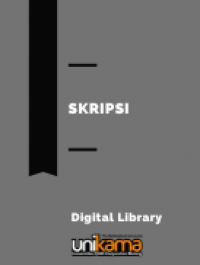
Electronic Resource
An Analysis Of Illocutionary Act On Conversations Between Teacher And Students In The Classroom At One Year Profession Program Of I-Tech Zainul Hasan Probolinggo
This study is to analyze the types of illocutionary act on conversations between teacher and students in the classroom. It is not too easy for people to understand all the illocutionary act types because every type has characteristics. The conversation between the teacher and the students contains some real actions indicated by the utterance and intended for the listener to do something. Thus, the researcher was interested in analyzing the utterances in conversation between teacher and students in the classroom based on types of illocutionary act.
Data were collected by recording the conversations between teacher and students in the classroom. Then, it was analyzed using descriptive methods. The researcher chose the theory of illocutionary act types by Searle to analyze the illocutionary act types of the utterances in the data.
Based on the data analysis there were 24 utterances of types of illocutionary act found in the conversations between teacher and students in the classroom. The types were assertive, directive, commissive, and expressive. However, declarative illocutionary act was not found. The mostly type of illocutionary act used through utterances in the conversations between teacher and students were directives and expressives (33,3%).The forms of directives were suggesting, asking, commanding and ordering. Those happened when the teacher or students as hearer did something like what the speaker (teacher or students) wanted. Moreover, expressives forms were expressive of apologizing, expressive of greeting, expressives of congratulating, expressive of disapproval, expressive of welcome somebody, and expressive of thanking. These happened when the teacher or students as speaker expressed the psychological attitude. The second rank was assertives (29,2%). The forms of assertive were informing and indirect directives. They were found when the teacher committed to the truth express and the students not only informed but also gave indirect imperative to the teacher. Furthermore, the lowest rank was commissive (4,3%). The commisives form was promising. Those were done when the teacher committed to some future actions.
Finally, this research is expected to be a reference for students of English department and lecturers in general and also future researchers of pragmatics field which are interested in exploring the works of illocutionary in conversations between teacher and students in the classroom
Ketersediaan
| 2121752/SB/2015 | KKI 420 WAR a/s | Perpustakaan Unikama | Tersedia |
Informasi Detail
- Judul Seri
-
-
- No. Panggil
-
KKI 420 WAR a/s
- Penerbit
- Malang : Pendidikan Bahasa Inggris-Unikama., 2015
- Deskripsi Fisik
-
viii, 61 hlm
- Bahasa
-
English
- ISBN/ISSN
-
-
- Klasifikasi
-
420
- Tipe Isi
-
text
- Tipe Media
-
PDF
- Tipe Pembawa
-
-
- Edisi
-
-
- Subjek
- Info Detail Spesifik
-
-
- Pernyataan Tanggungjawab
-
-
Versi lain/terkait
Tidak tersedia versi lain
Lampiran Berkas
Komentar
Anda harus masuk sebelum memberikan komentar
 Karya Umum
Karya Umum  Filsafat
Filsafat  Agama
Agama  Ilmu-ilmu Sosial
Ilmu-ilmu Sosial  Bahasa
Bahasa  Ilmu-ilmu Murni
Ilmu-ilmu Murni  Ilmu-ilmu Terapan
Ilmu-ilmu Terapan  Kesenian, Hiburan, dan Olahraga
Kesenian, Hiburan, dan Olahraga  Kesusastraan
Kesusastraan  Geografi dan Sejarah
Geografi dan Sejarah